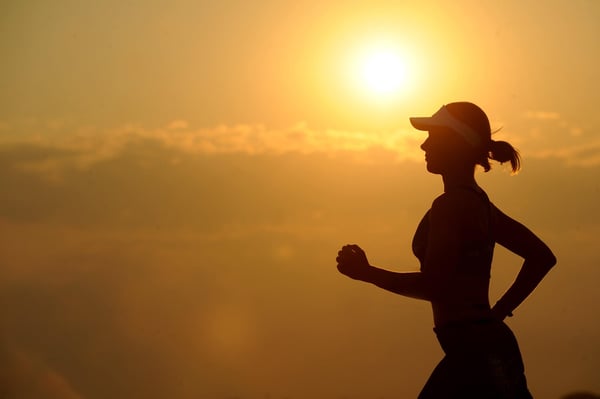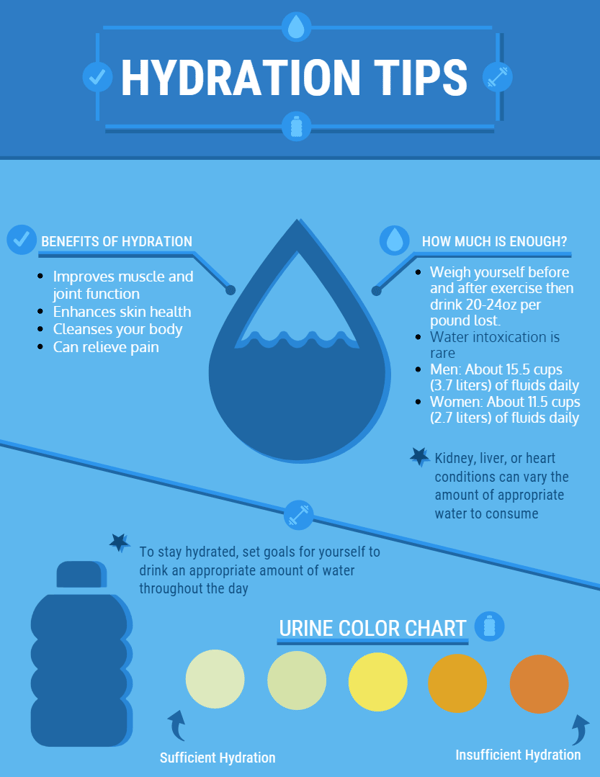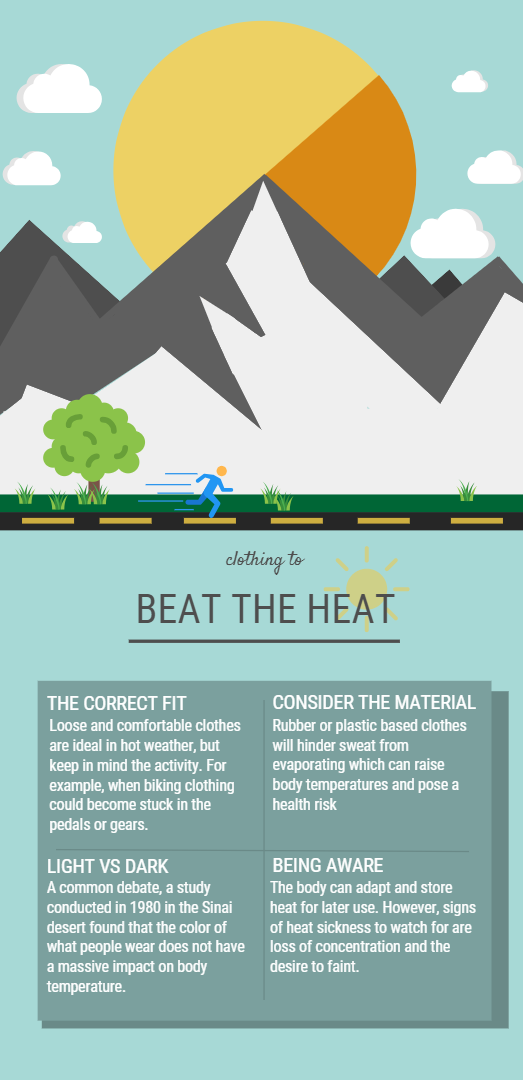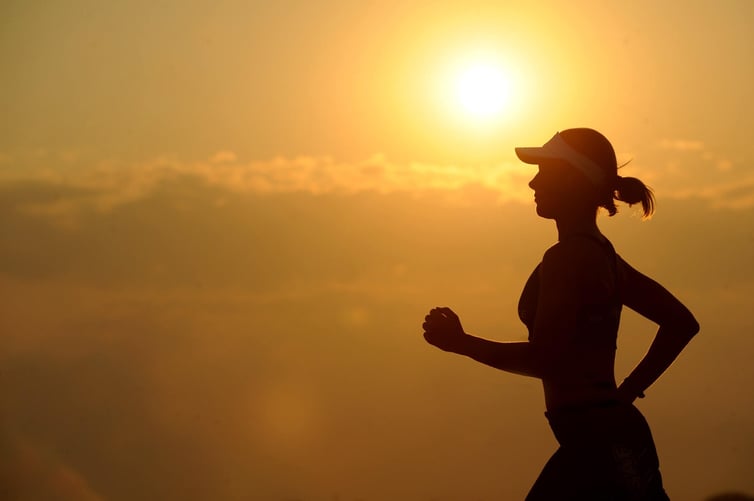By CCM Exercise Physiologist and Registered Dietitian Nutritionist, Laura Bollinger
I was too tired. Something else came up. It was rainy. It was snowing. It was too dark. It was too cold. It was too hot.
As a health coach, I hear these statements all the time. Members share with me many reasons why they chose to do something other than exercise during the time they had scheduled for it.
Depending on the circumstances, these could be valid reasons or just excuses. Between you and me, however, most individuals know very clearly whether it is a valid reason or an excuse.
As the summer ebbs on, and very high temperatures persist in many areas of the country, the most likely weather concern for exercise will be heat. While the risks are real, understanding those risks and taking simple steps to adjust for the heat allows exercise to be safe and beneficial even when the thermostat soars.

Acclimatization
Did you know that the more you exercise in the heat, the better your body becomes at handling the heat? Working up to it gradually and consistently is the key.
Adaptations that occur include:
- Your body will start to produce more sweat sooner and with less electrolyte loss
- Your blood vessels will dilate and constrict appropriately in different body systems to direct blood flow as it is most needed
- The same intensity of work will feel easier
Is it safe to exercise in the heat?
As a Certified Athletic Trainer who has worked with a variety of sports ranging from high school cross country to Oklahoma State University football, I can tell you from personal experience that precautions certainly should be taken when considering exercising in the heat.
Deciding not to exercise at all, however, is generally not necessary and can be detrimental to your health goals.
Here are some questions to consider:
- How acclimatized is your body?
- As many Chicago marathoners learned in 2007, if your training to date has been mostly in milder weather, your body will not perform the same under more extreme temperatures.
- When temperatures soar higher than what you have been experiencing recently, keep the workout shorter and less intense than you typically would until your body has had time to adjust. (More on acclimatization later!)
- What are you wearing?
- Helmets and heavy padding can increase the risk for heat-related illnesses. You may opt for a “non-contact” day so that you can wear lighter clothing.
- Are you well-hydrated when you begin your exercise session?
- According to the National Strength and Conditioning Association (easy test = light-colored urine), an easy test to do prior to starting exercise is to check the color of your urine.

- What is your hydration strategy during exercise? Do you have water available on the sidelines? Can you carry water while you run or on your bike?
- As recommended by the National Athletic Trainers Association, the goal is to match your sweat loss with your water intake during exercise. It’s important to pay attention to thirst signals. If you are thirsty during exercise you should drink water, but excess fluid should not be consumed.
- If your exercise is quite intense or lasting more than an hour, electrolyte replenishment may also be a consideration.
- How humid is it?
- God designed sweat to cool your body off as it evaporates, but high humidity can reduce the rate of evaporation, greatly reducing sweat’s effectiveness.
How hot is too hot?
There are various heat illnesses and I have been witness to several different instances of them. Each time, the signs were recognized and the individual recovered. Ice baths or cool towels, slow re-hydration, and rest in the shade were usually all that was needed. In some cases, EMTs who could provide IV fluid replacement were necessary.
However, I also have had a friend in his 20s pass away as a result of heat stroke while working construction. The risks are real. The key is to know what to look for and then to respond appropriately.
The American Red Cross lists these signs of heat illness, sometimes called heat exhaustion:
- Cool, moist, pale or flushed skin
- Heavy sweating
- Headache
- Nausea
- Dizziness
- Weakness
- Exhaustion
If you notice these signs in yourself or others around you, exercise should stop and measures should be taken to cool down and slowly rehydrate. However, if those measures do not result in symptoms improving, 911 should be called.
Heat stroke is a life-threatening condition that warrants immediate medical attention. Signs include:
- Hot, red skin which may be dry or moist
- Changes in consciousness
- Vomiting and high body temperature
So, does that mean that we should just stay inside all summer? In my opinion, the physical, spiritual, and emotional benefits of moving your body in fresh air and enjoying God’s creation far outweigh the risks in the vast majority of cases. And, I believe God’s design of our bodies supports my theory. Otherwise, why would He build into our bodies such an amazing capacity to adjust to the stress that high temperatures places on them?
Can I get as good a workout in the heat?
Ultimately, exercising in the heat can be beneficial and rewarding. Most of us are well aware of what the Centers for Disease Control has been saying for years about how regular exercise aids us with weight control, reduces risks of cardiovascular disease, diabetes, cancer, and injury from falls.
Exercise alone, but outdoor exercise even more so, improves our mental health and mood. You can prepare appropriately for exercise in high temperatures by knowing the conditions and knowing your body.
The first few warm days, do not expect to go as long or as hard as you normally would. However, gradually you will notice the heat affecting you less. Start the workout hydrated and have a hydration strategy during the workout.
One way to assess your sweat losses is to weigh yourself before and immediately after exercise. Since your hydration rate ideally matches your sweat rate, no weight should be lost. But many will find that they have lost weight during an especially sweaty workout.
Normal food and fluid consumption can typically restore hydration status. But if you find that you are having difficulty restoring your hydration status, aim to consume 16 - 24 ounces of fluid for every pound lost during exercise.
How can I reduce my risk?
There are several ways you can reduce your risk for heat-related illnesses. Review these ideas and choose the right options for you:
- Choose light-colored, loose-fitting, and moisture-wicking clothing
- Minimize the use of helmets and padding if possible
- Gradually increase exercise intensity and duration over 10-14 days to fully acclimate
- Choose cooler times to exercise, avoiding the hottest part of the day between 10 am and 5 pm
- Stay hydrated before, during, and after exercise

Conclusion
Know the warning signs of heat illness and how to respond. And, maybe most importantly, have a backup plan! If heat, or cold, or snow, or rain make exercise outside less-than-appealing to you … simply exercise inside!!
While you may not get the equivalent intensity by walking around your mall prior to the stores opening, or by using an exercise video you found on YouTube, it is certainly better than doing nothing at all!
Now, get out there, be smart, and enjoy working up a sweat this summer!
Resources
American Red Cross. (2015, July 29). Too Hot? Know the Signs of Heat Exhaustion and Heat Stroke. Retrieved May 24, 2018, from http://www.redcross.org/news/article/Stay-Safe-during-Extreme-Heat
Bushman, B. A. (2013). Exercise in the Heat and Adequate Hydration. ACSMs Health & Fitness Journal,17(4), 4-7. doi:10.1249/fit.0b013e318296bdda
Centers for Disease Control and Prevention. (2018, February 13). Physical Activity and Health. Retrieved May 24, 2018, from https://www.cdc.gov/physicalactivity/basics/pa-health/index.htm
Greenleaf, J. E., & Kaciuba-Uscilko, H. (1989, April). Acclimatization to Heat in Humans[Scholarly project]. In NASA Technical Memorandum. Retrieved May 24, 2018, from https://ntrs.nasa.gov/archive/nasa/casi.ntrs.nasa.gov/19890016187.pdf
Mcdermott, B. P., Anderson, S. A., Armstrong, L. E., Casa, D. J., Cheuvront, S. N., Cooper, L., . . . Roberts, W. O. (2017). National Athletic Trainers Association Position Statement: Fluid Replacement for the Physically Active. Journal of Athletic Training,52(9), 877-895. doi:10.4085/1062-6050-52.9.02
NSCA. (n.d.). Trainer Tips: Hydration. Retrieved May 24, 2018, from https://www.nsca.com/education/articles/trainer-tips/hydration/
Roy, B. A. (2013). Exercise and Fluid Replacement. ACSMs Health & Fitness Journal,17(4), 3. doi:10.1249/fit.0b013e318296bc4b
Thigpen, D. E. (2015, May 26). Melt Down. Retrieved May 24, 2018, from https://www.runnersworld.com/races/2007-chicago-marathon-melt-down





